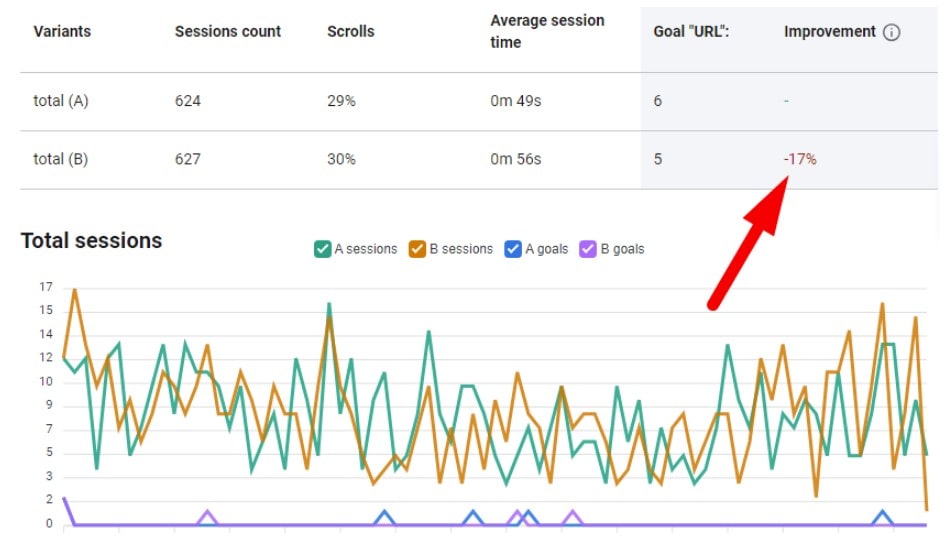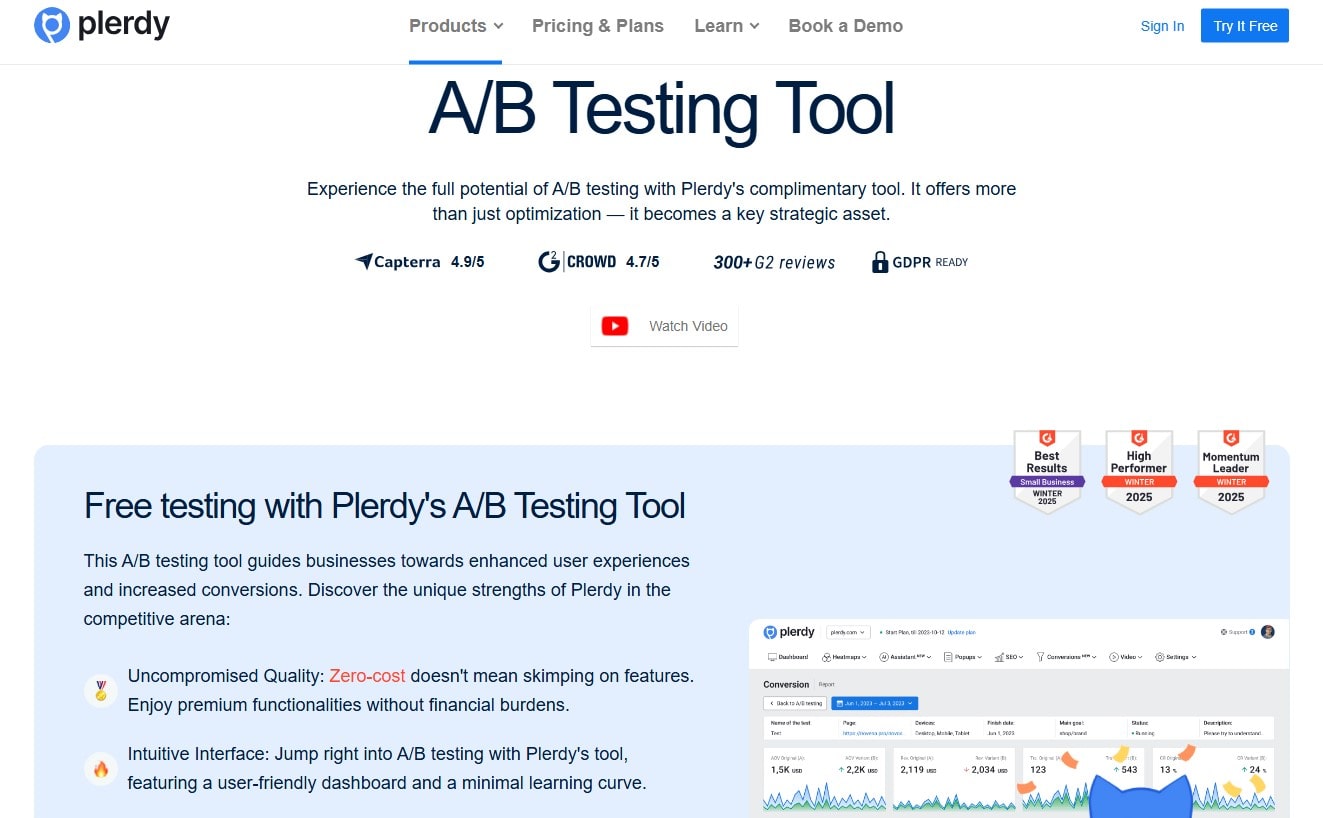A/B testing is like a science experiment for your website—except instead of mixing chemicals, you’re tweaking buttons, headlines, and CTAs to see what makes users tick. And guess what? Plerdy makes it ridiculously easy to run these experiments without the headache of complex setups.
This guide will walk you through running A/B tests effectively, optimizing your website’s conversion rates, and getting the best results using Plerdy’s powerful tools.
Why A/B Testing is a Game-Changer (And Why You’re Probably Doing It Wrong)
If you’re just throwing up random changes on your site and praying for better conversions, stop. A/B testing is not about guessing. It’s about data-driven decisions. When done right, A/B tests can:
- Increase conversion rates (some businesses see up to 40% more sign-ups just by tweaking a CTA color).
- Improve user experience by eliminating friction points.
- Help you understand what works for YOUR audience, not just what worked for a guru in 2019.
But here’s the catch—bad A/B tests can mislead you. Sample size too small? Data not segmented? Testing too many variables at once? Congratulations, you’ve just wasted weeks of effort.
With Plerdy’s optimization tools, you avoid these pitfalls while making smarter, faster, and more profitable decisions.
Setting Up A/B Tests with Plerdy in Minutes

A/B testing shouldn’t feel like launching a rocket. Plerdy keeps it simple:
- Choose what to test – Headlines, CTAs, pricing display, forms, anything that could affect conversions.
- Create variations – No coding needed! Plerdy allows you to tweak elements visually.
- Split traffic – Define the audience size for each version without disrupting user experience.
- Track real-time results – See which version converts better with Plerdy’s Website Funnel Analysis.
- Apply winning changes – Once you have enough data, implement what works and move on to the next test.
Unlike some overpriced A/B testing platforms, Plerdy integrates heatmaps, click tracking, and user behavior insights in one dashboard, so you’re not just testing blindly—you’re optimizing with precision.
What to Test? A/B Test Ideas That Actually Move the Needle

If you’re not sure where to start, steal these high-impact A/B test ideas:
🏆 1. Headlines & Copy
The first thing people read determines whether they stay or leave. Test:
- Short vs. long headlines (“Boost Sales” vs. “Boost Your Sales by 40% in 2 Weeks”).
- Emotional triggers (“Stop Losing Money on Ads!” vs. “Optimize Your Ads for Maximum ROI”).
- Power words (Free, Exclusive, Instant, Proven, etc.).
🔥 2. Call-to-Action (CTA)
Your CTA button is your money-maker. Test:
- Color changes (Red vs. Green – HubSpot saw a 21% lift just from this).
- Wording tweaks (“Get Started” vs. “Claim Your Free Trial Now”).
- Placement (above the fold vs. bottom of the page).
📱 3. Mobile vs. Desktop Experience
Visitors behave differently on mobile. Test:
- Sticky vs. non-sticky buttons.
- Long forms vs. multi-step forms.
- Different checkout flows for desktop and mobile users.
With Plerdy’s mobile-specific heatmaps, you can see how mobile users interact with your tests and make laser-focused changes.
Analyzing A/B Test Results (Without Falling Into Common Traps)
Running an A/B test is one thing—reading the data correctly is another. Many businesses make the mistake of calling a winner too soon. You need statistical significance.
| Mistake | Why It’s a Problem | How Plerdy Helps |
|---|---|---|
| Testing for too short a time | Results may be random and misleading. | Plerdy tracks long-term trends. |
| Ignoring traffic segments | Different users behave differently. | Plerdy allows audience filtering. |
| Changing multiple things at once | You won’t know what caused the improvement. | Test one change at a time with Plerdy. |
Plerdy vs. Other A/B Testing Tools: What Makes It Stand Out?

There are plenty of A/B testing tools out there—Optimizely, Google Optimize (RIP), VWO—but Plerdy brings something extra to the table:
- All-in-one: A/B testing, heatmaps, and conversion tracking in one dashboard.
- No coding required: Anyone on your team can set up and run tests.
- Real-time data: No waiting for reports—see user behavior as it happens.
- Cost-effective: Unlike enterprise tools that charge $$$, Plerdy keeps it affordable.
And let’s be real—why juggle 3-4 different tools when Plerdy does it all?
Actionable Strategies for Maximizing A/B Test Results
- Set a clear goal – Don’t test random things. Define what success looks like (e.g., 15% more sign-ups).
- Give it time – Aim for at least two weeks of testing to get accurate data.
- Segment your audience – What works for new visitors might not work for returning customers.
- Look beyond just conversions – Analyze engagement, bounce rates, time on page.
- Iterate and refine – A/B testing is a cycle, not a one-time task. Keep optimizing.
The Takeaway: Use Plerdy to A/B Test Smarter, Not Harder
If you want to stop guessing and start growing, A/B testing is a must. But doing it right? That’s where Plerdy’s optimization tools come in.
With easy setup, deep insights, and real-time tracking, you’ll have everything you need to run effective, data-backed tests without wasting time or money.
So why not test something today? Small changes can lead to big wins, and Plerdy’s got your back every step of the way.
FAQ: How to Run Effective A/B Tests?
What is an A/B Test and why is it important for my website?
An A/B Test is a data-driven experiment where two versions of a webpage element—like headlines, CTAs, or pricing displays—are compared to see which performs better. This testing method helps you make informed decisions, improve conversion rates, and enhance the user experience without relying on guesswork.
How can I set up an A/B Test quickly using Plerdy?
Plerdy simplifies the process by letting you create variations of your website elements without any coding. You just choose what to test, split your traffic evenly, and start tracking real-time results with Plerdy’s integrated optimization tools, making it easy to pinpoint which version drives better performance.
Which elements should I consider for an A/B Test with Plerdy?
Focus on high-impact elements such as headlines, CTAs, and even mobile versus desktop experiences. Testing aspects like color, wording, placement, or form structure can lead to significant improvements in user engagement and conversion rates, especially when guided by Plerdy’s user behavior insights.
What common pitfalls should I avoid during an A/B Test?
Avoid mistakes like running tests for too short a period, testing multiple variables at once, or not segmenting your audience. These pitfalls can lead to misleading results. Plerdy helps you sidestep these issues by providing detailed, real-time data analysis and audience segmentation options to ensure your A/B Test results are both reliable and actionable.
How does Plerdy stand out from other A/B testing tools?
Plerdy offers an all-in-one dashboard that combines A/B testing, heatmaps, and conversion tracking, all without the need for coding. Its intuitive setup, cost-effectiveness, and real-time insights make it a powerful choice for anyone looking to run effective A/B Tests and make smarter optimization decisions.
